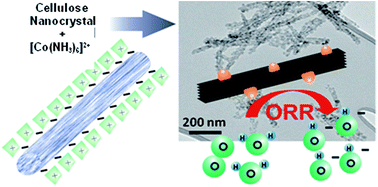Co3O4 nanoparticles/cellulose nanowhiskers-derived amorphous carbon nanoneedles: sustainable materials for supercapacitors and oxygen reduction electrocatalysis†
Abstract
Hybrid nanostructured materials comprised of amorphous carbon nanoneedles (CNN)-supported Co3O4 nanoparticles (Co3O4-CNN) were synthesized. The synthesis involved layer-by-layer nanocasting of cellulose nanowhiskers with precursors of cobalt oxide and silica, followed by pyrolysis of the core–shell–shell composite materials and etching of the outer silica shells from the carbonized materials. Notably, cotton-derived cellulose nanowhiskers were used as the carbon precursors, and also as the hard templates for needle-shaped carbons, in the synthesis. The effectiveness of the core–shell–shell nanoreactors, possessing the silica shell-entrapped cellulose nanowhiskers and Co(II) ions, in generating organized carbon nanomaterials with metal oxide nanoparticles, or otherwise, as a function of the loading of Co(II) ions was evaluated. Details of the synthetic method and the different materials in terms of composition and morphology it results in as a function of the relative amount of metal ions have also been discussed. The materials showed promising supercapacitive properties and electrocatalytic activity for the oxygen reduction reaction (ORR). The materials' double layer capacitance and performance for ORR electrocatalysis as a function of their Co3O4 content and particles size have also been discussed. The results indicated that the electrochemical properties of these hybrid materials are strongly related to the morphology of their carbon nanostructures. The synthetic method demonstrated here can potentially serve as a facile route to produce other metal oxide/carbon nanomaterials, with different morphologies and similar or better properties, using other carbon precursors.


 Please wait while we load your content...
Please wait while we load your content...